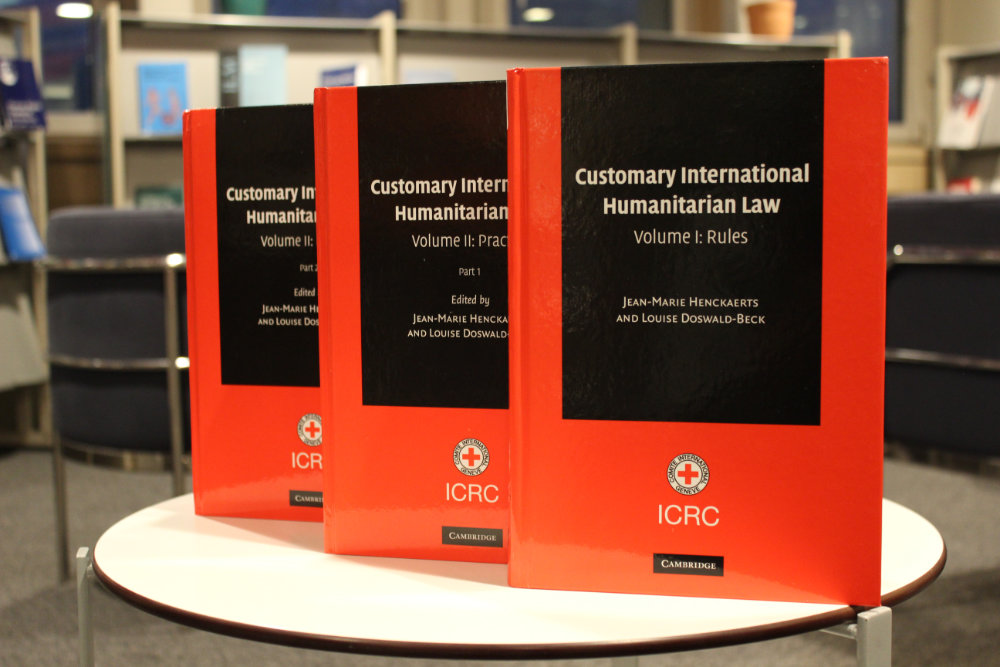The Fourth Geneva Convention was the first humanitarian law convention dedicated to protections for civilians during armed conflict. Amongst its numerous protective rules, it also provides the main rules of international humanitarian law (IHL) governing the exceptional practice of internment of protected persons – detention of such persons for security reasons during international armed conflict.
In this post, part of a series that delves into the grounds and procedures for internment contained in the Fourth Geneva Convention, Camilla Guldahl Cooper, Associate Professor at the Norwegian Defence Command and Staff College, gives some context to certain rules in the Fourth Geneva Convention which apply to the initial decision to intern a protected person. She elaborates on what these rules require and how they have been taken into account in Norway’s military manual.
Editor’s note: The forthcoming update of the Commentary on the Fourth Geneva Convention – an ICRC project seeking to provide current interpretations of the Conventions to enhance their understanding, dissemination and faithful application in today’s armed conflicts – will consider and address the rules explored in this blog series.
You were a member of the project group which developed Norway’s military manual with the assignment and approval of Norway’s Ministry of Defense. Could you please elaborate on the basis for rule 6.88 of the manual and its requirement to take internment decisions on an individual basis, and whether it is understood to be reflective of a legal obligation?
The Norwegian law of armed conflict (LOAC) manual combined law and policy in order to give the armed forces an easily accessible overview of what is expected of them. On the topic of detention, the manual is influenced by our human rights obligations, even though the official Norwegian position on the exact relationship between LOAC rules and human rights law is not clear.
Internment is a very serious intervention in the rights of the individual persons involved. The requirement to only intern civilians when it is “absolutely necessary” (GC IV, Article 42) is therefore interpreted to require a strict assessment of the need to intern. The person must pose a risk to the detaining power’s security which cannot be dealt with through less intrusive measures, such as being ordered to leave the area or being ordered to report to the police at a regular basis. These assessments are best done on an individual basis, in order to comply with the requirement that a civilian is only interned when absolutely necessary.
Staying with Rule 6.88, and recalling the individual vs. collective internment that was taking place when the drafters were debating the Fourth Geneva Convention, what are thoughts on the rationale presented at the Diplomatic Conference by those states supporting collective internment?
Collective internment will be challenging to reconcile with a requirement for internment decision being made on an individual basis. Although the argument for collective internment has some merit in that the individual assessment will be time consuming and resource intensive, collective internment will entail too great a risk of individuals being interned without it being absolutely necessary. The purpose of internment is not to punish, but rather to remove those participating directly in hostilities or otherwise presenting a serious security threat for as long as they continue to present such a threat. This requires concrete assessment.
Collective internment also does not sit well with the evolution of human rights and the increasingly common perception that some elements of international human rights standards, such as the prohibitions on arbitrary deprivation of life and arbitrary detention, apply during armed conflict.
What are some of the practical implications for Norwegian forces of rule 6.88 in situations where a number of persons need to be interned at once and urgently, within a conflict setting? That is to say, what would you understand the rule to require in such challenging circumstances?
The main argument against individual assessment is that it will be too complicated to carry out when dealing with large number of persons. However, rather than not conducting assessments on an individual basis, it is better to have an initial, expedited process, followed by a more detailed subsequent assessment.
As the manual explains in para. 6.99, the level of suspicion required to place a person in security internment depends on the specific situation, and this will also affect how extensive the initial assessment need to be. The seriousness of the threat and the urgency to deal with it are particularly relevant. If the threat is very serious, the required degree of suspicion will be lower than for less serious or less imminent threats. This enables the state to deal with more cases in a shorter period of time, and therefore deal with large numbers. The requirement is to ensure that there are reasonable grounds for believing that the person in question represents a serious threat to security and that it is therefore absolutely necessary to intern them.
Turning to the question of consideration of other measures available of a lesser severity than internment, according to Rule 6.96, for internment to be permissible, other options must be deemed insufficient. Could you please elaborate on the basis for this rule, if it is understood to be reflective of a legal obligation, and if so, from where does that obligation derive?
Internment is a preventive measure, i.e. it is used to prevent the person in question from engaging in hostile or threatening acts. In order to be lawful, the internment must be absolutely necessary, which is interpreted to entail that alternative measures are not sufficient or available. The availability or effectiveness of alternative measures will depend on the situation and conflict.
In conflicts taking place in the territory of the state, the state is likely to have the means to enforce alternatives such as home arrest, expulsion from an area, or requirement to regularly report to the police. An occupying state may have some of the same alternatives available, while the options for a state participating in a non-international armed conflict on another territory are considerably more limited.
What are some of the practical implications or requirements of Rule 6.96 or for Norwegian forces when seeking to intern civilians?
The process connected with the security detention will depend on the circumstances. In some cases, the initial internment is based on a perceived threat, which must then be confirmed as soon as possible. Whether this can be done at the scene or requires further consideration will depend on the type of threat, available resources, and the character of the situation at the time.
If the person in question is considered a lawful target of attack, due to his or her direct participation in hostilities, there are few, if any, realistic alternatives to detention once the person is under the control of the armed forces. If the armed forces holding a person is in doubt on whether internment would comply with applicable rules of engagement and procedures developed to ensure compliance with LOAC, the person can be interned temporarily until the determination is made by higher levels of command. In such cases, there would usually be a temporal limitation for making the determination and if needed, release the person.
In other situations, if a known person is considered to be a security risk, the appropriate measures can be considered by the appropriate level of command and staff officers. The role of the armed forces involved in interning the person would then be to comply with the order to intern, in accordance with the operational procedures in place setting out amongst others the amount of force that may be used.
Do you have any thoughts on how Rule 6.96 could be applied in situations where an internment decision must be taken quickly?
In addition to the legal limitation on interment, due to the operational and logistical challenges involved in having to ensure appropriate treatment of interned persons and transport them back to an appropriate facility, the decision is never taken lightly. In most cases, the initial decision to intern is a reaction to emergent situations, such as a perceived threat or suspicious activity, and the decision must be made quickly.
To aid the troops in making the decision, they may be provided examples of situations where internment is appropriate. Such operation specific examples can for instance be issued in standard operating procedures (SOPs) or tactical directives, or be included as part of the training. The need to intern will then be subject to a more detailed consideration conducted by qualified personnel once the internee is brought onto a military facility.
Compilation of rules discussed from Norwegian Manual
Rule 6.88
Internment shall not be a routine measure and may only be implemented on the basis of an individual assessment of the threat presented by a given individual, without discrimination of any kind.
Rule 6.96
Internment is a serious intervention in personal liberty, and the conditions under which it may be imposed are therefore strict. In order for security internment of a civilian in an armed conflict to be permissible, other options such as deportation, obligatory periodic reporting to the police for registration or similar measures must be deemed insufficient to safeguard security.
Rule 6.99
No specific level of suspicion can be established as a requirement, but there must be reasonable grounds for believing that the person in question represents a serious threat to security and that it is therefore absolutely necessary to intern him or her. The level of suspicion required to place a person in security internment depends on the specific situation. The seriousness of the threat will be among the relevant factors. If the threat is very serious, such as specific information that one or more persons will attack Norwegian forces with lethal means in the near future, a smaller degree of suspicion will be required than if the question is one of interning a person suspected of passing along information that is of military value but does not constitute a specific deadly threat to Norwegian forces.
See also:
- Jelena Pejic, Civilian internment in international armed conflict: when does it begin?, May 23, 2024
- Mikhail Orkin, The internment of protected persons and the Fourth Geneva Convention, May 16, 2024
- Giulio Bartolini, Voluntary reports: a new tool ‘toward a universal culture of compliance with IHL’, April 11, 2024






Comments